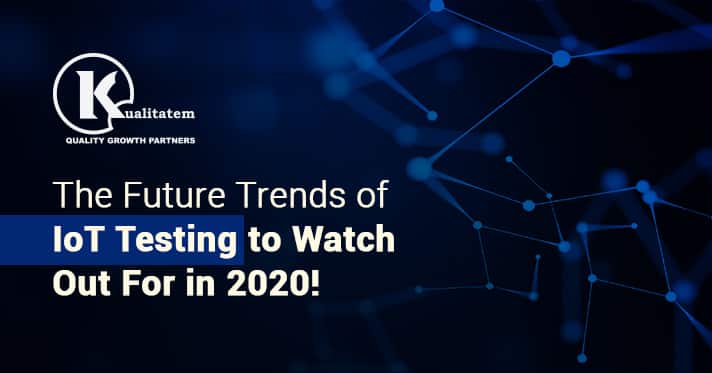Future Trends of IoT Testing to Watch Out For in 2020!

- January 3, 2020
- HibaSulaiman
IoT deals with millions of interconnected devices such as smartphones, smartwatches, and tablets for data collection and exchange, enabling users to access information from anywhere in the world. As these devices continue to increase rapidly in number, it brings forth new challenges and opportunities in the IoT testing space. Today, a good IoT software testing company involves real-time intelligence and communication to ensure perfect harmony between hardware and software throughout the connected network. In this article, we’ll look upon some of the major upcoming trends that will influence IoT testing.
Artificial Intelligence
It’s the era of artificial intelligence where all industries are reaping benefits from it. Its potential is far from achieved, especially in the field of application development. To reduce human involvement in the complex, as well as tedious tasks, enterprises are moving towards AI. It equips applications with self-learning capabilities to make them work smartly and ensure faster deployments within limited infrastructure and resources. In IoT testing, AI will ensure more reliable results compared to manual testing, minimizing inaccuracies and discrepancies. It can be used to drive automation, expand coverage, and enhance efficiency in all areas of IoT testing.
Big Data Testing
A growing number of devices mean huge amounts of data that require a unique approach to testing and a well-planned strategy to follow. Data generated by IoT systems can pose challenges in testing. Testing techniques vary for different types of data sets throughout data ingestion, data integration, data standardization, etc. To cater to big data testing requirements, professionals will need to adapt to the latest testing skills. Moreover, this process demands various analytical tools, techniques, and frameworks to test large amounts of datasets for which traditional testing techniques are not sufficient.
Micro-Services Test Automation
As traditional testing is no longer sufficient in the expanding IoT ecosystem, enterprises are inclined towards adopting test automation. However, considering the dynamism of deployment and scalability expectations of IoT, Microservices will become an integral part of the IoT ecosystem.
Microservice architecture involves the development of a single application that can work together as a suite of small services. In the case of IoT, each of these services can run as an individual process and communicate with lightweight mechanisms like an HTTP resource API. Microservices test automation in IoT is expected to reduce the complexity of testing a huge architecture as each microservice can be tested as a separate process. Utilizing Microservices for IoT testing will also offer benefits of testing extensibility, scalability, and integrations of the IoT system.
Service Virtualization for Simulation of Smart Homes
Home automation is one of the emerging trends. Major tech giants such as Apple, Amazon, and Google are rolling out the smart home devices that connect with different home appliances to give you remote access. For testers, it’s kind of alien territory. Testers need to understand factors such as the layout of homes and what other devices are present. Teams have to model different types of houses, sensors, and devices.
Conclusion
Although working for an IoT software testing company may be a challenging job, it is also very exciting. The complicated mesh of devices, protocols, hardware, operating systems, firmware and so on makes for a compelling engineering challenge, one that testing teams tend to relish rather than shy away from. As a result, there is reason to be confident that we will see the tremendous potential of IoT come to fruition in the next couple of decades.
And as the Internet of Things continues to grow, we can expect to see the continued advancement of technology into new areas and applications. As such, there will be a continual challenge for QA teams to devise the testing procedures that will secure the further expansion of IoT technology into these new and exciting fields.











